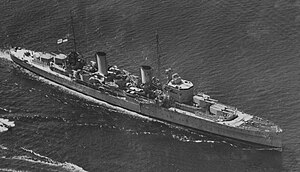HMAS Perth (1934)

HMAS Perth in 1940
|
|
| History | |
|---|---|
|
|
|
| Name: | Amphion |
| Builder: | Portsmouth Naval Dockyard |
| Laid down: | 26 June 1933 |
| Launched: | 27 July 1934 |
| Commissioned: | 15 June 1936 |
| Decommissioned: | 1939 |
| Identification: | Pennant number: I29 |
| Fate: | Sold to Royal Australian Navy |
|
|
|
| Name: | Perth |
| Namesake: | City of Perth, Western Australia |
| Acquired: | 1939 |
| Commissioned: | 29 June 1939 |
| Identification: | Pennant number: D29 |
| Motto: |
|
| Honours and awards: |
|
| Fate: | Sunk in action, Sunda Strait, 1 March 1942 |
| General characteristics | |
| Class and type: | Modified Leander-class light cruiser |
| Displacement: | 6,830 tons (standard) |
| Length: |
|
| Beam: | 56 ft 8 in (17.27 m) |
| Draught: | 19 ft 7 in (5.97 m) |
| Installed power: | 72,000 shaft horsepower (54,000 kW) |
| Propulsion: |
|
| Speed: | 31.7 knots (58.7 km/h; 36.5 mph) |
| Range: |
|
| Complement: |
|
| Armament: |
|
| Aircraft carried: | 1 × seaplane |
HMAS Perth was a modified Leander-class light cruiser operated by the Royal Australian Navy (RAN) during the early part of World War II. She was constructed for the Royal Navy, where she was commissioned as HMS Amphion in 1936. After several years on the North America and West Indies Station, the cruiser was transferred to the RAN in 1939 and recommissioned as HMAS Perth.
At the start of World War II, Perth was used to patrol Western Atlantic and then Australian waters, before she was sent to the Mediterranean Sea at the end of 1940. There, Perth was involved in the Battle of Greece and the Battle of Crete, and the Syria-Lebanon Campaign before returning to Australian waters in late 1941.
In February 1942, Perth survived the Allied defeat at the Battle of the Java Sea, only then to be torpedoed and sunk by the Imperial Japanese Navy at the Battle of Sunda Strait. Of the 681 sailors aboard, 353 were killed in battle. All but four of the 328 survivors were captured as prisoners of war: 106 died in captivity, and the surviving 218 were returned home to Australia after the war.
In late 2013, divers found that the wreck of Perth had been partially stripped by Indonesian marine salvagers.
The ship was one of three Modified Leander-class light cruisers constructed for the Royal Navy. She had a displacement of 6,830 tons, with a length overall of 562 feet 3.875 inches (171.39603 m), a length between perpendiculars of 530 feet (160 m), a beam of 56 feet 8 inches (17.27 m), and a draught of 19 feet 7 inches (5.97 m). The main difference to the previous five Leanders was that the newer ships had their machinery and propulsion equipment organised in two self-contained units (two Parsons geared turbines and two Admiralty 3-drum boilers in each machinery space), allowing the ship to continue operating if one set was damaged. The two exhaust funnels, one for each machinery space, gave the modified ships a different profile from the early Leanders, which had a single funnel. To cover the separate machinery spaces, the side armour was extended from 84 to 141 feet (26 to 43 m), negating the weight reduction created by the separation. The machinery spaces produced 72,000 shaft horsepower (54,000 kW) for the four propellers, and could drive the ship to a maximum speed of 31.7 knots (58.7 km/h; 36.5 mph). At top speed, the cruiser could travel 1,780 nautical miles (3,300 km; 2,050 mi), while the more economical speed of 22.7 knots (42.0 km/h; 26.1 mph) produced a maximum range of 6,060 nautical miles (11,220 km; 6,970 mi).
...
Wikipedia
